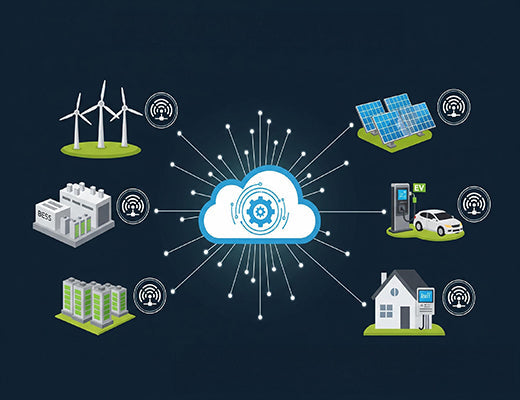
The Fusion of IoT and Energy: Powering a Smarter, More Resilient Future
|
|
Time to read 5 min
|
|
Time to read 5 min
The convergence of the Internet of Things (IoT) and energy management is creating a smarter, more resilient, and more efficient grid. By deploying ruggedized sensors and industrial gateways, IoT technology enables the real-time, two-way communication needed to monitor and control a new generation of distributed energy assets. From automating the smart grid and optimizing renewable energy production to building scalable EV charging networks, IoT in the energy sector is the key to navigating the complexities of the global energy transition.
IoT is the core technology driving the modernization of the energy sector, transforming the traditional one-way grid into a dynamic, two-way network.
Key applications for IoT and energy include smart grid automation, efficient remote management of renewable energy assets like wind and solar farms, and the connectivity backbone for smart EV charging networks and Battery Energy Storage Systems (BESS).
The harsh, remote environments of energy infrastructure demand rugged, secure, and remotely manageable industrial IoT devices for reliable connectivity.
Real-world IIoT deployments in the energy sector have proven to reduce operational costs by up to 30% and cut unplanned downtime by 25% through predictive maintenance.
For the last century, our electrical grid worked like a one-way street: large power plants generated electricity, and it flowed outwards to consumers. It was a simple, reliable system for a simpler time. But today, that one-way street is transforming into a complex, multi-lane superhighway with traffic flowing in all directions. The rise of decentralized renewable energy sources like wind and solar, the massive demand from electric vehicle (EV) charging, and the need for greater efficiency have made the traditional grid obsolete.
How do you manage such a complex system in real-time? How do you balance supply and demand when the sun isn't shining or the wind isn't blowing?
Let's be clear: you do it with data. The fusion of IoT and energy is the central nervous system that allows this new, dynamic grid to function. It provides the real-time visibility and control needed to build a more resilient and sustainable energy future.

The core mission of
IoT in the energy sector is to enable secure, reliable, two-way communication between the thousands of distributed assets that make up the modern grid. It replaces slow, manual inspections and outdated communication lines with a real-time data network. This allows utility operators to:
Wind and solar farms are often located in remote, harsh environments, making maintenance incredibly expensive. The 'aha!' moment for renewable operators is realizing the immense ROI of remote monitoring.
cut unscheduled downtime by 25%, directly boosting energy revenue.
The electric vehicle revolution depends entirely on a robust and reliable charging network.

Energy infrastructure is mission-critical and almost always located in demanding outdoor or industrial environments. Using consumer-grade hardware is not an option.
The fusion of IoT and energy is the essential engine driving the global transition to a more sustainable, reliable, and efficient energy future. From optimizing a single wind turbine to managing an entire national grid, the ability to collect, transmit, and analyze data in real-time is paramount. By building these smart energy solutions on a foundation of rugged, secure, and reliable industrial IoT connectivity, we can meet the challenges of the 21st-century grid and power a smarter world.

A1: Energy assets like substations, wind turbines, and pipelines are often located in remote, geographically dispersed areas where wired internet like fiber is either unavailable or prohibitively expensive to install. Cellular provides a cost-effective, rapidly deployable, and highly reliable connectivity solution for these assets.
A2: SCADA (Supervisory Control and Data Acquisition) is the traditional centralized software system used by utilities to monitor and control industrial processes. IoT devices, like industrial routers and gateways, act as modern, intelligent Remote Terminal Units (RTUs) for these SCADA systems. They collect data from field assets and use cellular networks to securely transmit it back to the central SCADA host.
A3: It must be, and security is a top priority. All communications for critical infrastructure must be encrypted end-to-end using a secure VPN tunnel. The hardware itself must have a robust firewall and be developed under a certified secure lifecycle (like IEC 62443-4-1) to protect against cyber threats.